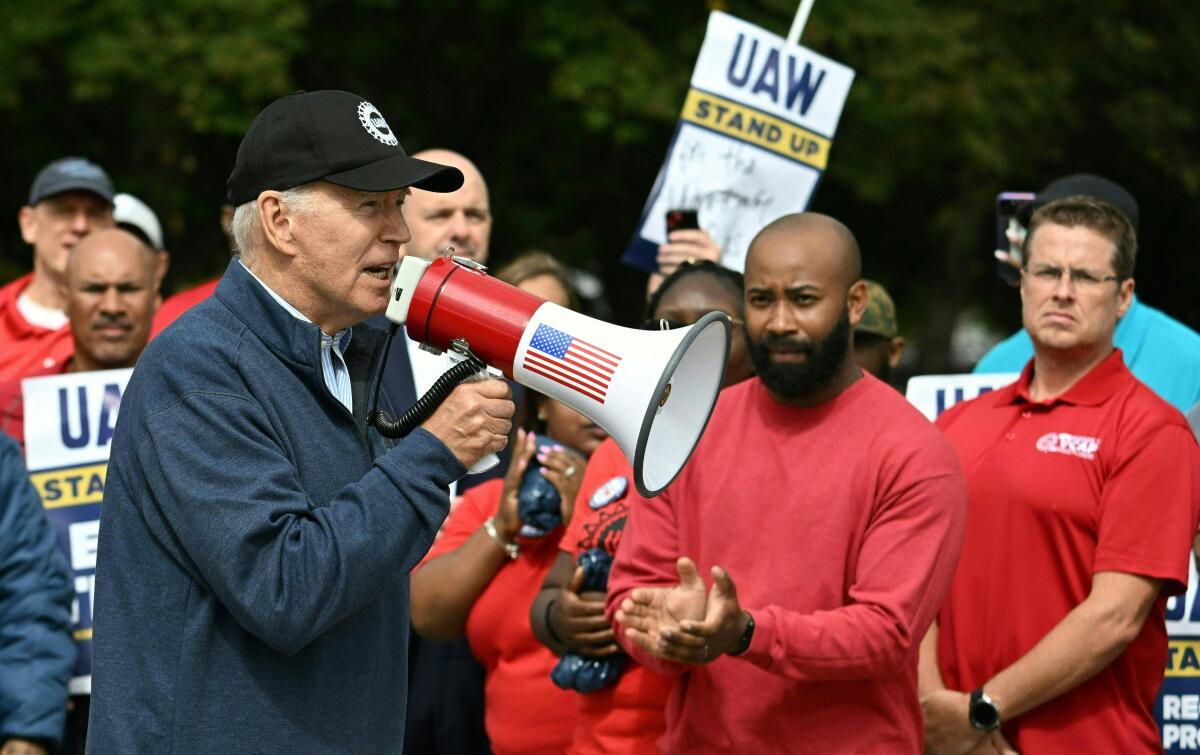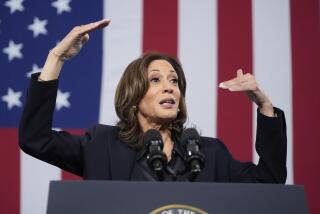Column: Biden and Trump want working-class votes. The economy may decide who gets them

- Share via
WASHINGTON — The battle for working-class voters is on, and it could well decide the outcome of the 2024 election.
Last week, President Biden and former President Trump hustled up to Michigan, where the United Auto Workers have gone on strike amid contract negotiations with GM, Ford and Stellantis, the company formerly known as Chrysler.
Biden joined striking workers on a picket line outside a GM parts facility, the first time an incumbent president showed his support for organized labor so thoroughly.
At the Republican debates, cameras turn on, the press shows up, the candidates appear on stage. But it’s all tangential to what’s really taking place.
“You saved the automobile industry back in 2008,” he told UAW members through a bullhorn. “But now they’re doing incredibly well. … It’s about time for them to step up for us.”
Trump didn’t visit striking workers or endorse the UAW’s demands for higher wages. He gave a speech at a nonunion factory and charged that Biden is hurting autoworkers by promoting electric vehicles.
“The workers of America, to put it very nicely, are getting screwed,” Trump said. “You can be loyal to American labor or you can be loyal to the environmental lunatics, but you can’t really be loyal to both.”
Biden disagrees, of course. He argues that clean energy industries can and should create high-wage union jobs. But UAW leaders complain that most subsidies from Biden’s energy legislation have flowed to nonunion factories, and they haven’t endorsed the president for reelection.
The battle for autoworkers’ hearts is a microcosm of a larger struggle for working-class voters, a category typically defined by pollsters as voters without a college degree. They make up about 60% of the electorate.
Working-class voters, especially union members and their families, were once the cornerstone of the Democratic Party. But over the past half-century, as Democrats became more liberal, millions of white, non-college-educated voters moved toward the GOP and its conservative social policies — a phenomenon political scientists call a “class inversion.”
“Did you ever think we’d be in a situation where blue-collar workers would vote Republican?” the president fretted to Democratic National Committee members earlier this year. “A lot of them came to believe we stopped paying attention to [the] working class the way we used to.”
In 2016, Trump won the presidency partly by winning almost two-thirds of white non-college voters, a major reason he prevailed in former Democratic strongholds such as Michigan, Wisconsin and Pennsylvania. Democratic candidate Hillary Clinton won only 28% of those voters.
In 2020, Trump won 65% of white working-class votes, but Biden improved on Clinton’s dismal performance by winning 33%, according to a study by the Pew Research Center. That was enough to move Michigan, Wisconsin and Pennsylvania into the Democratic column.
So Biden doesn’t need to win a majority of non-college-educated voters to keep his job in 2024, he just needs to do about as well as he did in 2020.
He especially needs to maintain his support among union members and their families, most of whom still vote Democratic. In 2020, Biden carried union households in Michigan by a whopping 25-percentage-point margin, 62% to 37%.
That’s why Biden so often reminds audiences that he considers himself “the most pro-union president in American history.”
Trump doesn’t make that claim. In his four years as president, he implemented a traditional Republican pro-business agenda and appointed anti-union members to the National Labor Relations Board.
His appeal to working-class voters in Michigan last week was a rerun of themes he ran on in 2016 and 2020, both cultural and economic.
“I’ve risked it all to defend the working class against the corrupt political class,” he claimed.
He promised to undo Biden’s clean energy mandates, promote oil and gas drilling, and impose high tariffs on foreign goods — all of which, he argued, would be good for autoworkers.
Biden, for all his history as a supporter of organized labor, has a harder case to make.
After two years of high inflation, most voters feel they are worse off financially than they were under Trump. And they’re right: Census Bureau estimates suggest that real household income, which began falling in 2020, hasn’t yet returned to its pre-pandemic high.
Biden’s answer has been an array of economic stimulus, investments in infrastructure and clean energy, and policies to promote higher wages — a package he has dubbed “Bidenomics.”
But even though real wages have grown faster than prices in recent months, most working-class families tell pollsters they still don’t feel better off.
Bidenomics is based on hopes that by this time next year, most Americans will notice that their paychecks are rising faster than their grocery bills, and will give the president credit.
But some Democrats are worried.
“The term ‘Bidenomics’ seems perfectly designed to annoy voters rather than win them over,” said Ruy Teixeira, a centrist Democratic political scientist.
Better, he suggested, for Biden to focus his pitch on the ways he’s nudging businesses to raise wages, including federal regulations requiring overtime pay for more workers.
Either way, unless the economy begins improving more dramatically, the 2024 election is likely to remain close. And both parties’ nominees — whoever they turn out to be — will spend a lot more time speaking to blue-collar workers in Michigan, Wisconsin and Pennsylvania.
More to Read
Get the L.A. Times Politics newsletter
Deeply reported insights into legislation, politics and policy from Sacramento, Washington and beyond. In your inbox three times per week.
You may occasionally receive promotional content from the Los Angeles Times.












